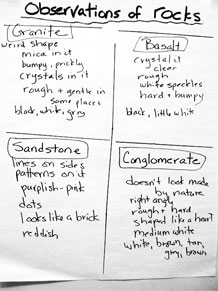What can we learn about rocks by observing them carefully?
3. Share the data

Compile students’ observations about the four rocks on the class chart. To speed the process, take one rock at a time, asking each student who observed that rock to provide a different observation.
What else did you observe about [granite]?
As students contribute their observations, make sure they distinguish between their data and their ideas about the data. Let them know they will discuss ideas and questions about the data in a minute. For now, they should simply list their observations about such things as color, size, texture, weight, shape, and composition. Let the students know that these characteristics of rocks are called properties.
Two types of observations are central to the goals of this session. It’s likely that students will include them, but if not, ask if anyone made an observation about:
- The number of different materials in their rock (leading to an understanding that rocks are made of minerals)
- The size, shape, or weight of the rocks themselves (reinforcing the distinction between an object and its materials)
Remind students that each section describes the properties of a particular rock. Next they will talk about the properties that all the rocks have in common.
How scientists share data. As the students share their data, let them know that scientists spend a great deal of their time doing the same thing. Sharing data creates a larger set of data, inspires new ideas, and builds knowledge. Some of the ways scientists share their data are through e–mail and teleconferencing, at conferences, and in publications.



